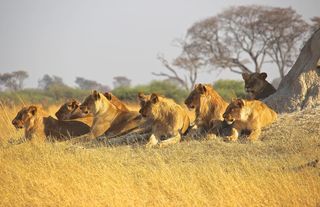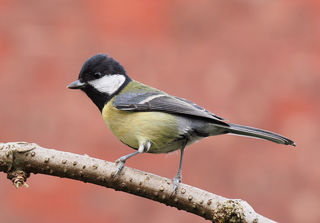Teamwork
The Upside of Eating Together
How sharing a meal improves well-being.
Posted November 29, 2019 Reviewed by Devon Frye
The connections we make and the experiences we share over food are not limited to humans. As many people all over the country are busy shopping, preparing, and traveling to sit down for a meal together, I wondered about other species that “sit” together at mealtime. Do they argue? Do they share a meal with family, friends, or both? Does coming together to eat bring them closer?

In lions, settling down on your haunches to feast on a meal is definitely a family affair. Females within a pride are related—but despite the cohesiveness and high level of cooperation that make up lion family life, mealtime is not without its tensions.
Even though they hunt together, there is an order to who gets to eat first. Males, who often have nothing to do with the preparation, muscle their way in and eat first. This may be similar to the ritual of the head of the family carving the meat and then taking the best piece for himself, even though he largely did not contribute to the success of the meal.
Beyond that, there is etiquette in lion society surrounding food. Principally, the protocol is that the female who made the kill is the "owner" and everyone acknowledges her right to the meal. After her, it is based on size, with—you guessed it—kids (cubs) coming in last place. Now, there might be some tension, some growling, some squabbles, and even a torn bloody ear—but overall, no one wants to get seriously hurt so there is a basic agreement to follow the rules even as they scramble to get a fair share from another greedy family member.
Gathering to feast with family, tensions notwithstanding, is fairly ubiquitous and fosters a sense of community and support. The same is true when friends are welcomed to join in. Indeed, inviting a friend to share a meal, especially at a time normally reserved for family, is a sure sign in many primate species that you are in the inner circle. It also means there is plenty to eat!
And it’s not just the invited guest that benefits, but also the one sharing the food. Research shows that after just a single food sharing event, the levels of circulating oxytocin are higher and promote social bonding and higher levels of cooperation in chimpanzees, bonobos, and humans. That means being generous with others you don’t know very well can expand your community of support and solidifies cooperation.
But remember, for all of our willingness to share, many of us still don’t like it if you take food directly off our plates. I covered this in a previous post ("Don’t Touch My Food!") and it is akin to violating lion social etiquette and taking food right out of a lion’s mouth (ill-advised).

When it comes to party planning, not all of us are equally comfortable organizing a dinner gathering. We share this variability with other species, like the Great tit (Parus major), where some individuals take the lead and are natural born social planners. They are like the hub on a bicycle tire connecting the spokes together. Like us, studies on Great tits show that personality influences not only who feels more comfortable orchestrating where to feed, but that those individuals with bolder personalities also like to eat with others. These are the people that throw a meticulously planned get together, prefer having holiday dinners at their house, and really enjoy governing the event, while others prefer to simply attend.
This time of year is a time for many of us to gather around a table and share a meal together, perhaps with family, maybe with friends, and sometimes even with strangers. For some of us, the holidays, like Thanksgiving, can be a time of tension, political arguments, or complicated family dynamics. For others, it is a time for celebration, coming together in communion, and sharing. When it comes to the food, sometimes there will be bickering over the best piece, or an individual that scrambles to take as much as possible lest the best dish is picked clean with no chance for seconds. Most of the time, however, there is a moment when the taste and enjoyment of the food is heightened, elevated by the presence of others.
Think about how you spend these moments together, consider inviting others to the table, and share your food with those who have no one to sit down with and eat a meal wrapped in the comfort and support of community.
References
Wittig, Roman M et al. “Food sharing is linked to urinary oxytocin levels and bonding in related and unrelated wild chimpanzees.” Proceedings. Biological sciences vol. 281,1778 20133096. 15 Jan. 2014, doi:10.1098/rspb.2013.3096
Aplin Lucy M., Farine Damien R., Mann Richard P. and Sheldon Ben C. Individual-level personality influences social foraging and collective behaviour in wild birds281Proc. R. Soc. Bhttp://doi.org/10.1098/rspb.2014.1016


